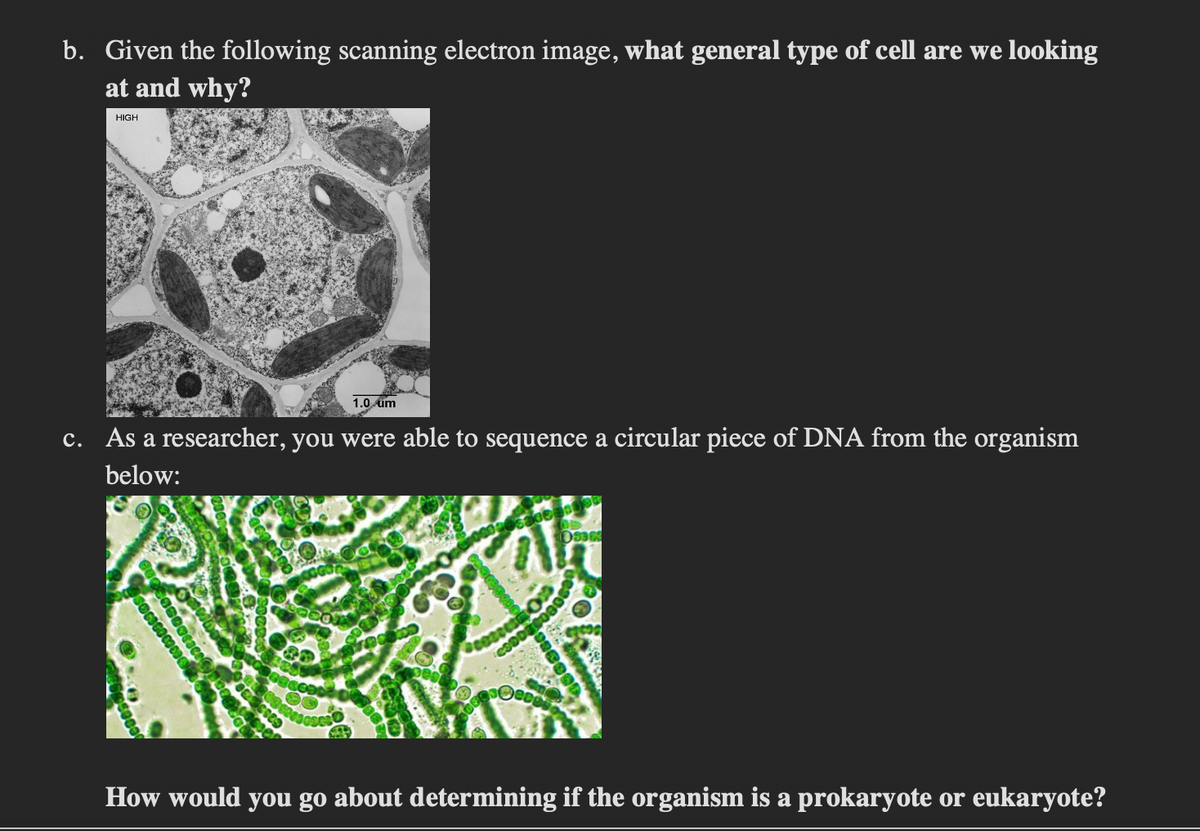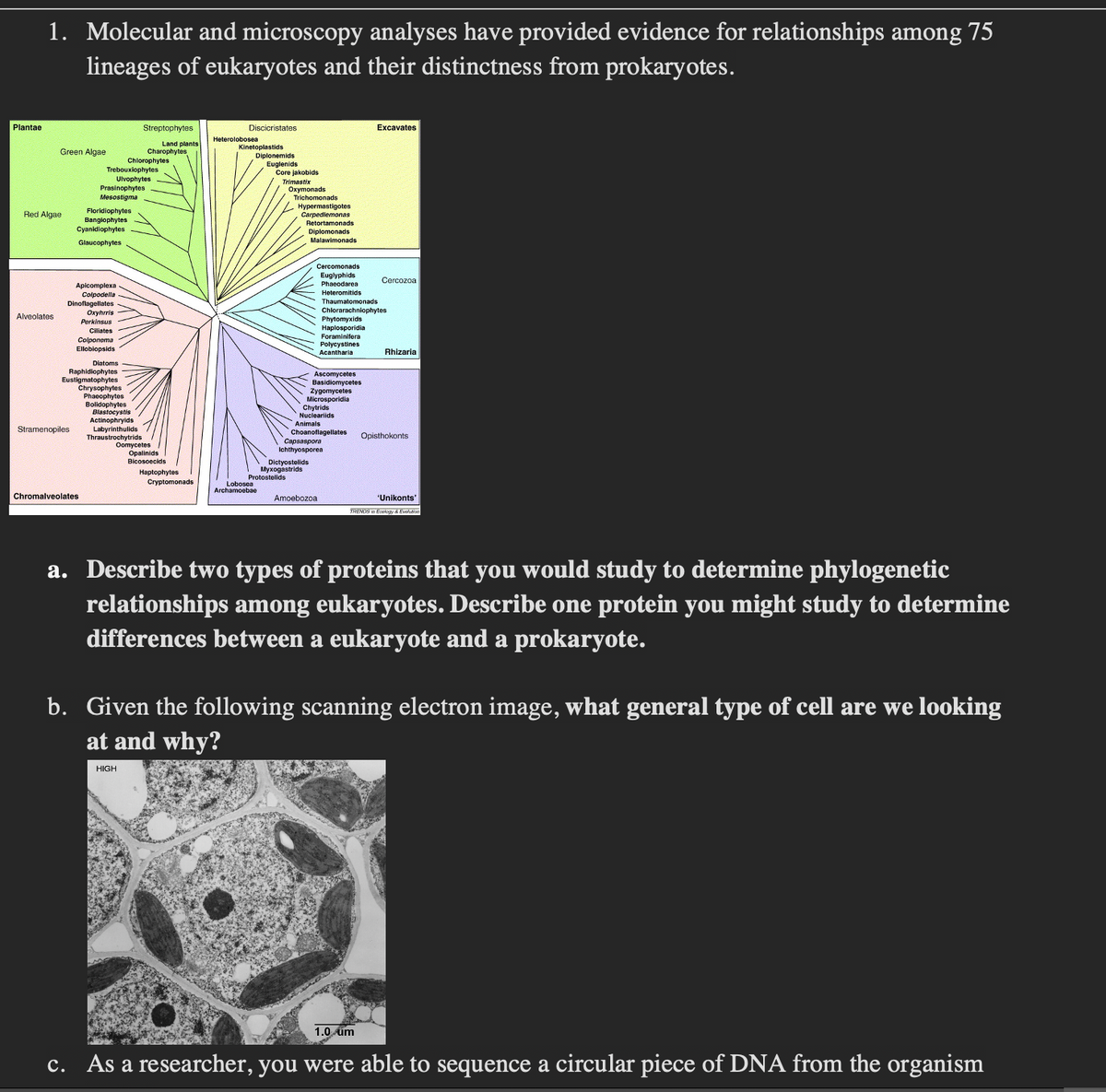ven the following scanning electron image, what general type of cell are we looking and why? 1.0 um a researcher, you were able to sequence a circular piece of DNA from the organism OW: 08363 w would you go about determining if the organism is a prokaryote or eukaryote?
ven the following scanning electron image, what general type of cell are we looking and why? 1.0 um a researcher, you were able to sequence a circular piece of DNA from the organism OW: 08363 w would you go about determining if the organism is a prokaryote or eukaryote?
Biomedical Instrumentation Systems
1st Edition
ISBN:9781133478294
Author:Chatterjee
Publisher:Chatterjee
Chapter24: New Technologies And Advances In Medical Instrumentation
Section: Chapter Questions
Problem 10P
Related questions
Question

Transcribed Image Text:b. Given the following scanning electron image, what general type of cell are we looking
at and why?
HIGH
1.0 um
c. As a researcher, you were able to sequence a circular piece of DNA from the organism
below:
cace
M40205330
08363
CODDEGOED
How would you go about determining if the organism is a prokaryote or eukaryote?

Transcribed Image Text:Plantae
1. Molecular and microscopy analyses have provided evidence for relationships among 75
lineages of eukaryotes and their distinctness from prokaryotes.
Green Algae
Red Algae
Alveolates
Stramenopiles
Chlorophytes
Trebouxiophytes
Floridiophytes
Bangiophytes
Cyanidiophytes
Glaucophytes
Apicomplexa
Colpodella
Dinoflagellates
Ulvophytes
Prasinophytes
Mesostigma
Oxyhrris
Perkinsus
Ciliates
Colponema
Ellobiopsids
Diatoms.
Raphidiophytes
Eustigmatophytes
Chromalveolates
Chrysophytes
Phaeophytes
Bolidophytes
Blastocystis
Actinophryids
Labyrinthulids
Thraustrochytrids
Streptophytes
Land plants
Charophytes
Oomycetes
Opalinids
Bicosoecids
Haptophytes
HIGH
Cryptomonads
Discicristates
Heterolobosea
Kinetoplastids
Diplonemids
Euglenids
Core jakobids
Trimastix
Oxymonads
Trichomonads
Lobosea
Archamoebae
Hypermastigotes
Carpediemonas
Retortamonads
Diplomonads
Malawimonads
Cercomonads
Euglyphids
Phaeodarea
Heteromitids
Dictyostelids
Myxogastrids
Protostelids
Phytomyxids
Haplosporidia
Thaumatomonads
Chlorarachniophytes
Foraminifera
Polycystines
Acantharia
Ascomycetes
Basidiomycetes
Zygomycetes
Microsporidia
Chytrids
Nucleariids
Animals
Choanoflagellates
Amoebozoa
Capsaspora
Ichthyosporea
Excavates
Cercozoa
Rhizaria
Opisthokonts
'Unikonts
TRENDS in Ecology & Evolution
a. Describe two types of proteins that you would study to determine phylogenetic
relationships among eukaryotes. Describe one protein you might study to determine
differences between a eukaryote and a prokaryote.
b. Given the following scanning electron image, what general type of cell are we looking
at and why?
1.0 um
c. As a researcher, you were able to sequence a circular piece of DNA from the organism
Expert Solution
This question has been solved!
Explore an expertly crafted, step-by-step solution for a thorough understanding of key concepts.
Step by step
Solved in 2 steps

Knowledge Booster
Learn more about
Need a deep-dive on the concept behind this application? Look no further. Learn more about this topic, biology and related others by exploring similar questions and additional content below.Recommended textbooks for you


Biology Today and Tomorrow without Physiology (Mi…
Biology
ISBN:
9781305117396
Author:
Cecie Starr, Christine Evers, Lisa Starr
Publisher:
Cengage Learning


Biology Today and Tomorrow without Physiology (Mi…
Biology
ISBN:
9781305117396
Author:
Cecie Starr, Christine Evers, Lisa Starr
Publisher:
Cengage Learning